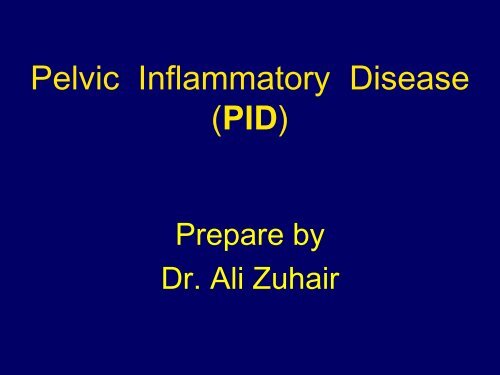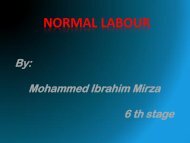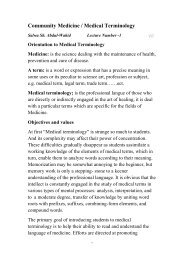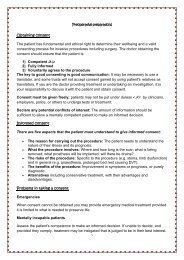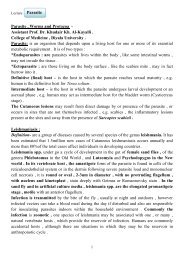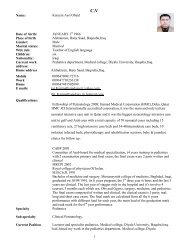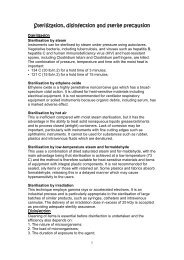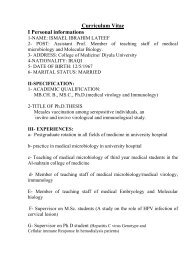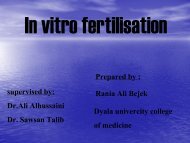Pelvic Inflammatory Disease (PID)
Pelvic Inflammatory Disease (PID)
Pelvic Inflammatory Disease (PID)
- No tags were found...
Create successful ePaper yourself
Turn your PDF publications into a flip-book with our unique Google optimized e-Paper software.
<strong>Pelvic</strong> <strong>Inflammatory</strong> <strong>Disease</strong>(<strong>PID</strong>)Prepare byDr. Ali Zuhair
Etiology• Neisseria gonorrhoeae common cause of <strong>PID</strong>(N. gonorrhoeae)– gram –ve diplococcus– rapid growth (20-40 min)– rapid & intense inflammatory response– 2 major sequelae• infertility & ectopic pregnancy, strong asso. with priorChalamydia infection• 85% of infection sexually active female of reproductive age• 15% of infection occur after procedures that break cervicalmucous barrier
• C. trachomatis– produce mild form of salpingitis– slow growth (48-72 hr)– intracellular organism– insidious onset– remain in tubes for months/years afterinitial colonization of upper genital tract
<strong>PID</strong> ?2 type:Acute <strong>PID</strong>-hs is often prolonged periodfollowed by gradual onset ofpelvic pain-irregular bleeding-by examination :+abdominal tenderness+guarding+and extreme tendernessof the vaginal fornices andcervical excitationCHRONIC <strong>PID</strong>-Pt complain of pelvic pain madeworse during the period-irregular bleeding and heavy-by examination :+some swelling may feltBut often there is little to findexcept tenderness in the fornices
RX :1-a laproscopy is advisable if thedoubt2-an intrauterine device if in theuterus should be remove3- given broad spectrum ABsuch as(doxycycline,azithromycin orampincillin )4- if acute sign and symptom spersist , a laparotomy performto search for abscess formation5- no surgical procedure beyonddrainage should be performedRx :1-rest2-a broad spectrum AB is given3-lapratomy and drainage donefor hydrosalpinx and abscessformation4-dyspareunea(painful coitus )May be relieved by correcting theuterine retroversion with a slingoperation5- in advance cases : the effectiverx is removal of the uterus andtube and perhaps the ovaries aswell
ACUTE PELVIC INFLAMMTORY DISEASE
CRONIC PELVIC INFLAMMTORY DISEASE
Risk factors• Strong correlation between exposureto STD• Age of 1 st intercourse• Frequency of intercourse• Number of sexual partners• Marital status ; 33% nulliparous
Risk factors• Reinfection untreated male partners 80%• Decrease risk- barrier method- OC• Increase risk– surgical procedure– previous acute <strong>PID</strong>
Clinical features• Common clinical manifestation– lower abdominal pain 90%– cervical motion tenderness– adnexal tenderness– Fever– cervical discharge– leukocytosis
Differential Diagnosis• acute appendicitis• Endometriosis• torsion/rupture adx mass• ectopic preg• lower genital tract infection
<strong>PID</strong>• 75% asso. endocervical infection & coexistpurulent vaginal d/c
<strong>PID</strong> Dx• CBC• ESR• C-reactive protein• Vaginal & cervical swab• U/S, CT, MRI• Culdocentesis: refers to a procedure in whichperitoneal fluid is aspiratedtransvaginally from the (pouch of Douglas).• Laparoscopic visualization– most accurate method for confirm <strong>PID</strong>
<strong>PID</strong>
Sequelae•Infertility– ¼ of pt have acute salpingitis– occur 20%– infertility rate increase direct with numberof episodes of acute pelvic infection
Sequelae•Ectopic pregnancy– increase 6-10 fold– 50% occur in fallopian tubes (previoussalpingitis)
Sequelae•Chronic pelvic pain– 4 times higher after acute salpingitis– caused by hydrosalpinx, adhesion around ovaries– should undergo laparoscope R/o other disease•TOA (tubo ovarian absess )10%•Mortality– acute <strong>PID</strong> 1%– rupture TOA 5-10%
Treatment• Therapeutic goal– eliminate acute infection & symptoms– prevent long-term sequelae
Criteria for hospitalization
CDC (centre for disease control )Recommended treatment regimens for OPD ofacute <strong>PID</strong>
CDC (centre for disease control )Recommendedtreatment regimens for IPD of acute <strong>PID</strong>
Treatment• Empirical ABx cover wide range of bacteria• Treatment start as soon as culture & diagnosisis confirmed/suspected• reevaluate 48-72 hrs of initial OPD therapy
Treatment• Rx male partners & education forprevention reinfection• Rx male partners regimens foruncomplicated gonorrhoeae &chlamydial infection– Ceftriaxone 125 mg im follow by•doxycycline (100) 1x2ʘ pc x7days or•azithromycin 1gmʘ or•ofloxacin (300) 1x2ʘ pc x7days
Surgical treatment• Laparotomy for– surgical emergencies– definite Rx of failure medical treatment• Laparoscopy– consider in all pt with ddx of <strong>PID</strong> & withoutcontraindication• Evidence of current / previous abscess• Acute exacerbation of <strong>PID</strong> with bilateralTOA
Prevention‣ Risk reduction against sexually transmitted infectionsthrough barrier methods such as condoms.‣Going to the doctor immediately if symptoms of <strong>PID</strong>,sexually transmitted infections appear,‣Getting regular gynecological (pelvic) exams withSTI testing to screen for symptomless <strong>PID</strong> [8]‣Regularly scheduling STI testing with a physician anddiscussing which tests will be performed that session.
‣Getting a STI history from your current partner andinsisting they be tested and treated beforentercourse.‣Treating partners to prevent reinfection orspreading the infection to other people.‣Diligence in avoiding vaginal activity, particularlyintercourse, after the end of a pregnancy (delivery,miscarriage, or abortion) or certain gynecologicalprocedures, to ensure that the cervix closes.
The End


